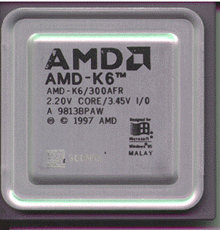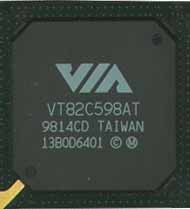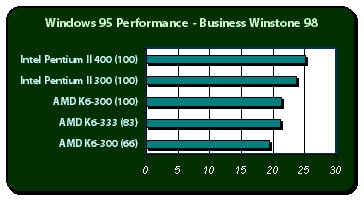
Original Link: https://www.anandtech.com/show/166
One of the biggest criticisms of AMD's K6 processors has been the low clock rate in comparison to their Pentium II counterparts. While Intel was pushing the 266MHz barrier AMD had just released their 200MHz chips. Intel released a 300MHz Pentium II, AMD responded by making a 233MHz K6 available in larger quantities. Intel once again pushed the limits with a 333MHz processor, AMD's answer? |
 |
| A delayed 266MHz K6...fortunately AMD managed to break through the "tradition" they had established with their newest processor, the AMD K6-300. Within a few weeks of releasing the highly anticipated, yet poorly timed release of the elusive K6-266, AMD leaked rumors of extremely high yields on the new 0.25 micron chips. These high yields translated into the possibility of a 300MHz K6 processor being released, but these were all rumors. Rumors that have since come true. | |
Looking on the web you can find quite a few vendors charging a decent price for the 266MHz K6, and now you can even find 300MHz parts at a competitive price. However from what we've learned from the K6-266, the performance in comparison to a Pentium II isn't too great, in fact, between the Pentium II - 266 and the K6-266, the Pentium II is a much better buy.
What makes things different with the K6-300? Nothing really. The 300MHz K6 is still slower than a Pentium II - 300, albeit about $25 cheaper. The price difference should be the reason you go for a K6-300 over a Pentium II - 300...with that settled, why on Earth would someone want a K6-300? There is one reason, and it's what makes this round different from the past, watch out Intel, it's AMD's turn now...
| Like the K6/266, the 300MHz version of AMD's 6th
generation line of processors operates at a unique 2.2v core voltage setting. This
may pose a problem for some older motherboards, but most newer boards do support this
setting. (For a comprehensive list of compatible motherboards, check out www.tweakit.com). As far as clock multipliers are concerned, the K6-300 is, again, much like its 266MHz brother in that it supports clock multipliers up to 5.0x, making overclocking almost encouraged by this cool running processor. |
 |
| A 4.5x clock multiplier is necessary for normal operation however, as the K6-300 operates at an external 66MHz bus with a 4.5x clock multiplier (66 x 4.5 = 300MHz). Note that the K6-300 is NOT the same thing as the upcoming K6/3D - 300 which operates at a 100MHz Front Side Bus Frequency. | |
BIOS Support is necessary for proper operation of the K6-300 as well, however in most cases a simple trip down to your motherboard manufacturer's Website will take care of that upgrade without much hassle. All AnandTech Motherboard Reviews list the manufacturer's web address at the bottom of each individual review.
All in all the K6-300 isn't much different from the 266, it inherits all of the wonderful qualities the 266 does, including excellent overclockability and literally cool operation, as well as its lackluster performance when compared to the massive (also meant to be interpreted literally) Pentium II. So we are posed with the same question once again...why would you want to buy a K6-300?
As mentioned in the K6/266 review, AMD announced a new standard for the Socket-7 Motherboard community, a combination of a standard Socket-7 motherboard with a few exceptions:
Support for the Accelerated Graphics Port Bus (AGP)
Support for the 100MHz Front Side Bus
Ability to run the PCI and AGP Buses at 33/66MHz respectively independently of the System Bus (FSB)
Full Support for all Super7 CPU's (K6 3D)
When this announcement was made, the world was left waiting for Super7 boards to actually make it out on to the market. The months flew by and empty promises from Acer Labs Inc (ALi) about their "killer" new Super7 chipset, the Aladdin V left many users turning to Intel for answers.
| What amazed most was the fact that VIA Technologies had completely forgone mentioning plans for a Super7 chipset at the time. They were working off the success of their Socket-7 AGP solution, the VP3 chipset that didn't even match up with the 83MHz bus speed setting until recently, it was obvious that 100MHz was out of the question. VIA managed to keep things quiet about their plans for the future of the dying Socket-7 market, but finally, just a few months ago, VIA managed to leak out some interesting information about their Mobile VP3 chipset...what would turn out to be the world's first Super7 chipset. |  |
| The MVP3 chipset was introduced to the world in a much lesser manner than the Aladdin V, everyone and their mother was boasting of an Aladdin V board in the works, in contrast very few manufacturers announced MVP3 based motherboards. So one can imagine the surprise when the first stable motherboard at 100MHz happened to be a VIA MVP3 based motherboard. Where are all the proposed Aladdin V boards? Is it true that only K6-266/300 processors will work at the 100MHz bus speed? What has been keeping us away from the 100MHz bus speed all this time...was it really our processors/RAM? Or something else? | |
When AnandTech received its first MVP3 based motherboard a few weeks ago, the Shuttle HOT-591P, the initial experience was a bit disappointing, the lack of a working 100MHz setting overshadowed the outstanding performance...the chipset seemed to be reminiscent of the SiS 5591 whose lack of stability at the 100MHz setting prevented it from blowing the minds of those that used it. The Shuttle board tested was a pre-production model, luckily a second MVP3 based motherboard made its way into the AnandTech Lab...this time the board was beyond impressive.
| EPoX, known for their excellent and easy to configure VP3 based AGP Socket-7 board, the P55-VP3, managed to produce the world's first stable Super7 motherboard - the MVP3 based EP-MVP3C-M. Not only did the MVP3C-M work at the 100MHz bus speed with the K6-300, it managed to work with the 266, 233, and 200 chips not to mention the Pentium MMX - 233 (the 6x86MX 200 I had isn't very overclockable, so I need to get a 233 or higher before I can come to any further conclusions). |  |
| Armed with the fully operational 100MHz bus speed on the MVP3C-M from EPoX, AMD managed to pull some amazing benchmarks out of their hat with the K6...so without further adieu, let's get to the comparison. | |
Performance
Test Configuration |
|
| Processor(s): | AMD K6/233 ANR AMD K6/266 AFR AMD K6/300 AFR Intel Pentium MMX 233 Cyrix 6x86MX-PR2/200 |
| RAM: | 1 - 64MB Corsair PC100 SDRAM DIMM |
| Hard Drive(s): | Western Digital Caviar AC21600H |
| Video Card(s): | Matrox Millennium II (4MB WRAM - PCI) |
| Bus Master Drivers: | VIA 2.14 |
| Video Drivers: | MGA Millennium 4.03.00.3410 VIA Gart VxD |
| Operation System(s): | Windows 95 Service Release 2.1 |
Note: BX Testing was done using the same configuration used in the ASUS P2B Review
Ziff Davis Winstone - Windows 95 Performance |
|||
| Winstone 98 | Winstone 97 | ||
| Business | Business | High End | |
| AMD K6/200 - 100MHz x 2.0 | --- | 57.4 | --- |
| AMD K6/291 - 83MHz x 3.5 | --- | 62.6 | --- |
| AMD K6/300 - 66MHz x 4.5 | 19.4 | 60.2 | --- |
| AMD K6/300 - 100MHz x 3.0 | 21.3 | 66.2 | 31.0 |
| AMD K6/333 - 83MHz x 4.0 | 21.1 | 64.8 | 30.6 |
Truly amazing, the K6-300 at 100 x 3.0 manages to crank out Pentium II - 300 scores when paired with the 100MHz bus speed on the MVP3C-M, if it weren't for the lack of an intermediate setting between the 2.2v and 2.8v core voltage settings on the board, I'm sure the K6-300 would have no problem making it up to 350MHz, we'll probably have to wait for some more MVP3 boards to be released for that wish to come true.

Pentium II vs K6? Under Winstone 97 the K6-300 does seem to cut it dead even with the Pentium II in terms of performance, however due to the difference in calculation of the final Winstone score, the K6-300 is outperformed by the Pentium II 300 (both running at a 100MHz bus) under Winstone 98. For the most part, there isn't much of a difference between the two.

Quake 2 - Gaming Performance |
||
| Timedemo - 640 x 480 | ||
| DEMO1 | DEMO2 | |
| AMD K6/300 - 66MHz x 4.5 | 12.4 | 11.4 |
| AMD K6/300 - 100MHz x 3.0 | 14.0 | 12.9 |
A 13% increase in Quake 2 performance courtesy of the 100MHz bus speed setting makes the K6 a much more appetizing chip. Toss in a 3D Graphics Accelerator and prepare to watch the frames fly. Current MVP3 boards seem to have some problems with the AGP Clock Divider, making 100MHz bus stability while using an AGP video card a difficult thing to predict. For the Quake 2 tests a PCI Millennium II was used, the AGP Riva 128 wouldn't boot at the 100MHz setting. This problem should be fixed shortly.
Again we are faced with the same dilemma, K6 or Pentium II? A quick recheck of the average prices on the Net resulted in a rewording of the Conclusion to this review. The AMD K6-300 and a MVP3 board will run you at least $100 less than a Pentium II 300/LX combo. That itself is a big enough difference to want to go with a K6-300, however it doesn't end there. In order to make a accurate comparison you must use a Pentium II - 300 running on a 100MHz bus speed, available on a BX board...making that price difference even more than $100.
AMD managed to pull a knock-out in this Second Round, let's see how well the availability of the K6-300 stands, and hopefully the price will continue to drop making this an even better deal. The K6-300 isn't the fastest thing out there, but for those of us that can't afford the outstanding price of the newly released Pentium II - 400 it becomes a much more intelligent choice.







